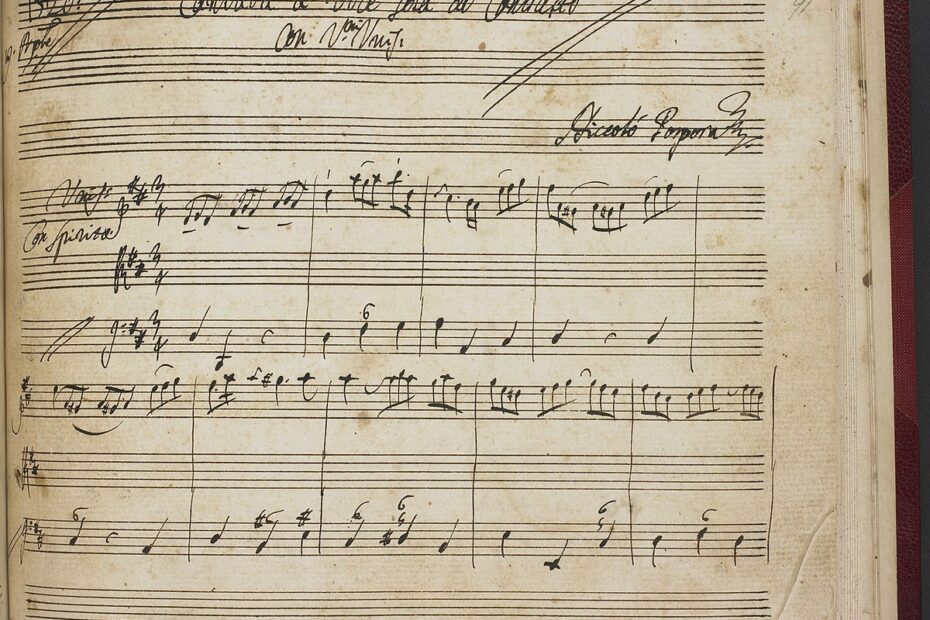The principles behind this series of editions are guided by maximum fidelity to the manuscript sources and an intimate knowledge of current performance practice.
Most manuscripts are from the British Library, Additional Manuscript collection, in particular a series of manuscripts collected by Signor Gaspar Selvaggi, of Naples, which were presented to the British Library by the Most Hon. the Marquess of Northampton. I am also fortunate in having access to the manuscripts of the Royal College of Music, London, the Naples Conservatorii and the Santini Collection in Diözesan Bibliotek Münster, Germany.
There are very few (6) known autograph manuscripts of Porpora’s cantatas, although his cantatas were widely copied during his lifetime and beyond. Unfortunately, often the copyists do not often include the wealth of detail provided by the composer. However, as the majority of Porpora’s output was vocal, it is possible to extrapolate the ways in which he phrased, ornamented and underlaid text in his cantatas from other works.
The autograph cantata Freme il mar and Porpora’s solo motets provide invaluable insight into the detail Porpora used in his solo vocal scores and the level of detail required for these editions to be truly representative of his work. Additionally the autograph manuscripts of his operatic output demonstrate the intensely detailed ‘harmonic world’ Porpora created, above all in recitatives.
The texts are often by either Metastasio (with whom Porpora maintained a close relationship during much of his composing career) or by other well-known poets. This means that there is often a verification/comparison available for the text in the work of another composer. Where the poet is untraceable, no comparison is available or the text is indecipherable the most likely reading has been used and the word or words have been enclosed in brackets.
The underlay has been maintained as in the sources. Both the underlay and beaming in Porpora’s autographs often indicate phrasing and where autograph manuscripts have been available, or the copy is particularly precise, this has been maintained in both vocal and instrumental parts.
Key signatures are maintained as in the manuscripts and follow the baroque practice of using one sharp or flat less than the equivalent modern key signature. In recitatives Porpora generally gives no key signature, allowing the line to move freely through widely disparate tonalities.

Time Signatures have been maintained as in the original copies and are generally the same as their modern equivalents. The main exception is that Porpora often grouped triple time measures in units of two. Where this occurs Porpora’s practice has been maintained, thus 3/4 may appear as 6/4 and 3/8 as 6/8.
The edition employs the following clefs: for instrumental parts, treble, alto, tenor and bass clefs following modern usage and for the vocal parts, treble clef.
Porpora followed the 18th century convention whereby chromatic inflections retain their validity only for as long as the note to which an accidental has been prefixed is repeated without interruption, irrespective of bar lines. Conversion to modern notation thus requires the occasional omission or addition of accidentals. In all other instances editorial accidentals are suggestions only and are enclosed in parentheses.
All ornaments and embellishments in this score are as in the manuscript sources. Porpora generally made use of two distinct trill-like ornaments, t and tr, and these have been maintained in the current editions. In copyists’ work it is unusual for more than just tr to be used and in transcribing these manuscripts I have used my discretion with reference to autograph manuscripts in this regard and these are detailed in the notes. Porpora also makes extensive use of the appoggiatura , both from above and below, and these are clearly indicated in the score. He does not use a slur when adding these embellishments, therefore I have tacitly omitted this.
Porpora makes use of a common 18th century articulation ( ‘ ) which can be interpreted as either a stress/accent on the note to which it is applied or, if appropriate, a lighter or shorter attack.
When writing triplets Porpora simply groups semi-quavers or quavers in threes, sometimes with no further indication. If it is particularly clear I have followed Porpora’s example omitting the numerical indication, otherwise modern usage has been employed.
Porpora used continuo figures both above and below the basso line. In this edition I have standardised this to place all continuo figures below the basso line. To clarify continuo accidentals, all have been converted to match the key signature in which they are found. In some copyists’ work there are few continuo figures and where the intention could be unclear I have provided figures in brackets as a guide.
Acknowledgements
I would like to thank Dr Rosalind Halton (University of Newcastle, Australia) and Dr Kate Eckersley for their invaluable assistance and inspiration both as performers and musicologists, as well as the staff at the various libraries who have made their manuscript collections available to me, in particular those at the British Library.
James Sanderson
August 2008

